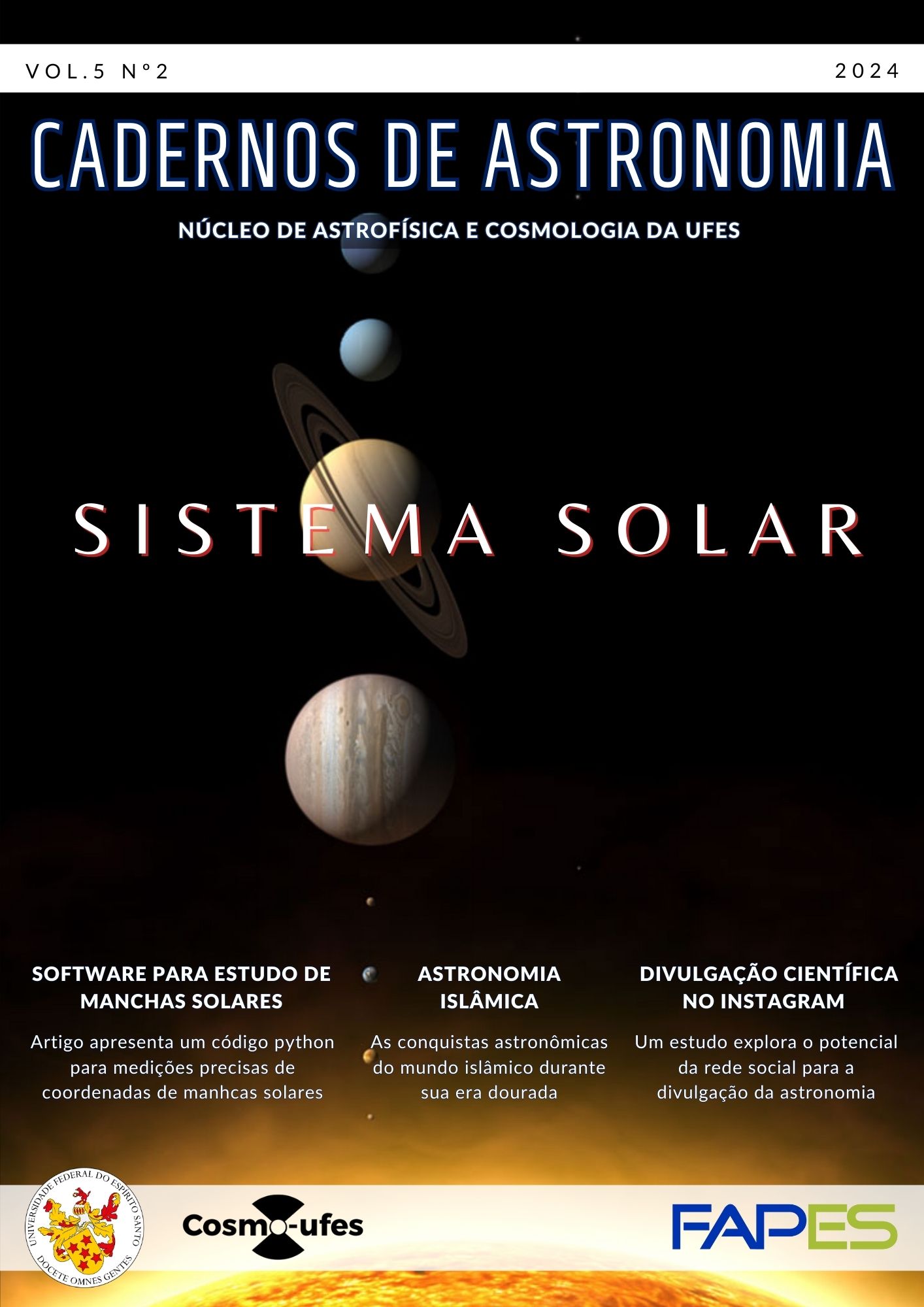DESI 2024: a possible indication of the end of the cosmological constant?
Keywords:
dark energy, DESI, cosmological constantAbstract
Discussion on the release of the first results from the Dark Energy Spectroscopic Instrument (DESI), based on the measurement of the impressions left by baryon acoustic oscillations in the distribution of galaxies and quasars. These results suggest, for the first time in academic literature, a temporal variation in the equation of state of the dark energy component of the universe. The DESI project is briefly explained, its operation and how modern cosmology can be impacted if this result is effectively consolidated by future observations.
Downloads
References
A. G. Adame et al., DESI 2024 VI: Cosmological Constraints from the Measurements of Baryon Acoustic Oscillations (2024). ArXiv:2404.03002.
H. Velten, Matéria escura, energia escura e a busca por uma nova teoria para a gravitação, Cadernos de Astronomia 1(1), 40 (2020).
I. J. Lewis et al., The Anglo-Australian Observatory 2dF facility, Monthly Notices of the Royal Astronomical Society 333(2), 279 (2002). ArXiv:astro-ph/0202175.
D. G. York et al., The Sloan Digital Sky Survey: Technical Summary, Astronomical Journal 120, 1579 (2000). ArXiv:astro-ph/0006396.
S. Weinberg, The Cosmological constant problems, in 4th International Symposium on Sources and Detection of Dark Matter in the Universe (DM 2000) (2000), 18–26. ArXiv:astro-ph/0005265.
A. G. Riess, The expansion of the Universe is faster than expected, Nature Reviews Physics 2(1), 10 (2019). ArXiv:2001.03624.
M. Chevallier e D. Polarski, Accelerating universes with scaling dark matter, International Journal of Modern Physics D 10(02), 213 (2001). ArXiv:gr-qc/0009008.
E. V. Linder, Exploring the expansion history of the universe, Physical Review Letters 90(9), 091301 (2003). ArXiv:astro-ph/0208512.
A. Albrecht et al., Report of the Dark Energy Task Force (2006). ArXiv:astro-ph/0609591.
N. Aghanim et al., Planck 2018 results. VI. Cosmological parameters, Astronomy & Astrophysics 641, A6 (2020), Erratum: Astron. Astrophys. 652, C4 (2021). ArXiv:1807.06209.
D. Brout et al., The Pantheon+ Analysis: Cosmological Constraints, The Astrophysical Journal 938(2), 110 (2022). ArXiv:2202.04077.
D. Rubin et al., Union Through UNITY: Cosmology with 2,000 SNe Using a Unified Bayesian Framework (2023). ArXiv:2311.12098.
B. O. Sánchez et al., The Dark Energy Survey Supernova Program: Light curves and 5-Year data release (2024). ArXiv:2406.05046.
J. Carron, M. Mirmelstein e A. Lewis, CMB lensing from Planck PR4 maps, JCAP 09, 039 (2022). ArXiv:2206.07773.
M. S. Madhavacheril et al., The Atacama Cosmology Telescope: DR6 Gravitational Lensing Map and Cosmological Parameters, The Astrophysical Journal 962(2), 113 (2024). ArXiv:2304.05203.
W. Giarè et al., Robust Preference for Dynamical Dark Energy in DESI BAO and SN Measurements (2024). ArXiv:2407.16689.
Z. Wang et al., The role of LRG1 and LRG2’s monopole in inferring the DESI 2024 BAO cosmology (2024). ArXiv:2405.02168.
V. Patel e L. Amendola, Comments on the prior dependence of the DESI results (2024). ArXiv:2407.06586.
G. Efstathiou, Evolving Dark Energy or Supernovae Systematics? (2024). ArXiv:2408.07175.
Downloads
Published
How to Cite
Issue
Section
License
Copyright (c) 2024 Hermano Velten, Rodrigo von Marttens

This work is licensed under a Creative Commons Attribution 4.0 International License.






